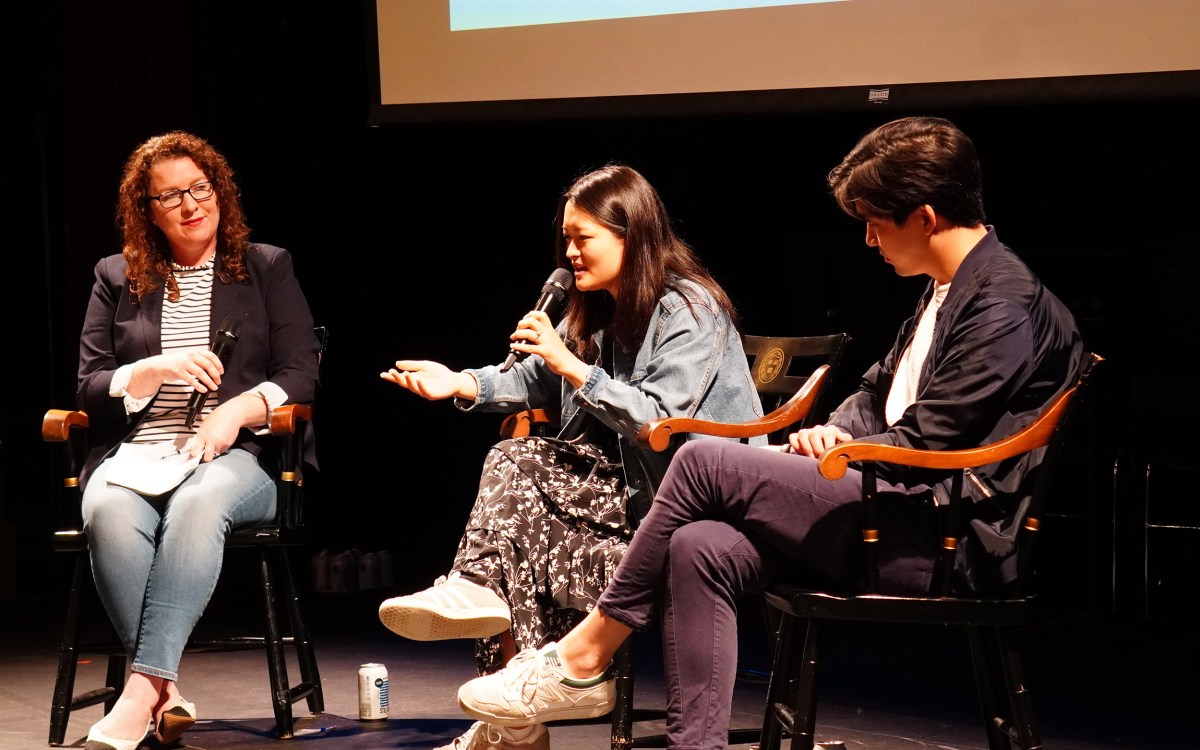Harvard Map Collection digitizes historic Cambridge and Boston atlases
The Harvard Map Collection’s atlases of historic Cambridge have much to reveal about the city and the University’s past. Looking at these oversized documents one learns, for instance, that 135 years ago, Harvard students boarded their horses in the University stables where the current-day John Harvard’s Brew House operates, and that, as of 1903, the John Harvard statue sat not outside University Hall but by Memorial Hall. Now the Map Collection has made it easier for those researching local history to use its Boston and Cambridge atlases by digitizing these volumes and making them available online to the public.
“The two kinds of atlases we’ve recently digitized for Cambridge and Boston are called fire-insurance and land-ownership atlases,” says David Cobb, curator of the Harvard Map Collection. “They’re unique and very significant, and they really provide far more detail than the regular maps of Cambridge and Boston.”
The land-ownership atlases, for example, reveal in tiny print just who owned what properties and when, says Cobb. The fire-insurance maps are equally meticulous, revealing building infrastructure details otherwise lost to history. Since insurance companies used fire-insurance atlases to quickly determine the cost of insuring a building against fire, they capture information regarding sprinkler systems, fire escapes, and types of construction. The latter is color-coded: yellow for wood, pink for brick, blue for stone.
“If you’re familiar with these maps, with a glance you know just what kind of construction you’re looking at,” says Cobb. “You’ll see what kind of windows a building had and where they were, whether there was an elevator, how many stories the building had. You get a lot of details.”
Both types of atlases provide a useful resource for anyone interested in local history, including, of course, academics. For instance, they reveal that in 1873 the land where Holyoke Center now sits was owned by a railroad company. A 1903 Bromley and Co. atlas includes Sever Hall and University Hall — with the John Harvard statue absent — but instead of Widener Library (built 10 years later) shows its predecessor Gore Hall. Likewise, Houghton, Lamont, and Pusey libraries had yet to be built, although Wadsworth House was standing, along with some of the older dormitories. Researchers can even see the locations of long-gone Harvard Square churches and where faculty were housed along Massachusetts Avenue 100 years ago.
Some use the land-ownership atlases for genealogy research to see where a given family lived. For others, the fire-insurance maps prove a valuable architectural tool for historical preservation. “People are coming back to see what these buildings originally looked like, because buildings obviously change over periods of time,” says Cobb. “These maps are perfect for people who want to come back and restore a building.”
All these details and more can be seen by calling up the maps in HOLLIS. According to Cobb, digitization makes the atlases more user-friendly. Since most of the originals are bulky, measuring two by three feet and two to three inches thick, they’re hard to handle and hard to reproduce. Now the atlases are more accessible, with users able to view them on their home computers, zoom in closely, and even print.
Another benefit is that, from a preservation standpoint, online perusal should save the physical atlases from future wear and tear, a welcome development since they have received particularly heavy use over the years.
Newly digitized atlases of Cambridge include the years 1873, 1885, 1886, 1894, 1900, 1903, and 1916. Due to copyright law, the Map Collection can’t digitize beyond that. Digitized years for Boston atlases include 1867, 1873, 1885, 1887, and 1902, each with seven volumes. In fact, the 1867 item was the very first fire-insurance atlas of Boston, made by Daniel Sanborn, a local surveyor from Somerville who founded the Sanborn Map Co. “Unfortunately,” explains Cobb, “there aren’t really any kind of similar maps prior to this date.”
For those interested in seeing exactly how much Harvard Square has changed since 1873, the Map Collection also plans to georeference two of the old Harvard-area atlases and include those images in the Harvard Geospatial Library.
“We’ll be able to take the historical image and overprint it on brand new GIS layers,” says Cobb. “We can take Cambridge’s current GIS building database and put the old buildings right over the top of it. I can assure you they don’t fit because the streets around Harvard Square have changed and obviously the buildings have changed, but you can get an idea and see it in a relatively accurate fashion. And a lot of buildings do still exist and will line up the way they should.”
The Cambridge and Boston atlas project began in January 2007 and Cobb credits its success to strong support from the Weissman Preservation Center and HCL Imaging Services. “It allows us to put more of our library out there 24/7 so that people don’t need us to open the doors to the physical collection,” he says.
The digitization of the Boston and Cambridge atlases is part of a larger Library Digital Initiative Project that the division calls “Imaging the Urban Environment” and that involves maps from 30 cities around the world. “We’re going to start with the earliest map of each city we have, usually somewhere in the 1570s or 1580s, and then digitally capture another map of the same city approximately every 50 years, up to 1900 or so,” Cobb says. “These can then be used by students, faculty, and researchers and scholars around the world to see a nice time-series analysis for these various cities.”




